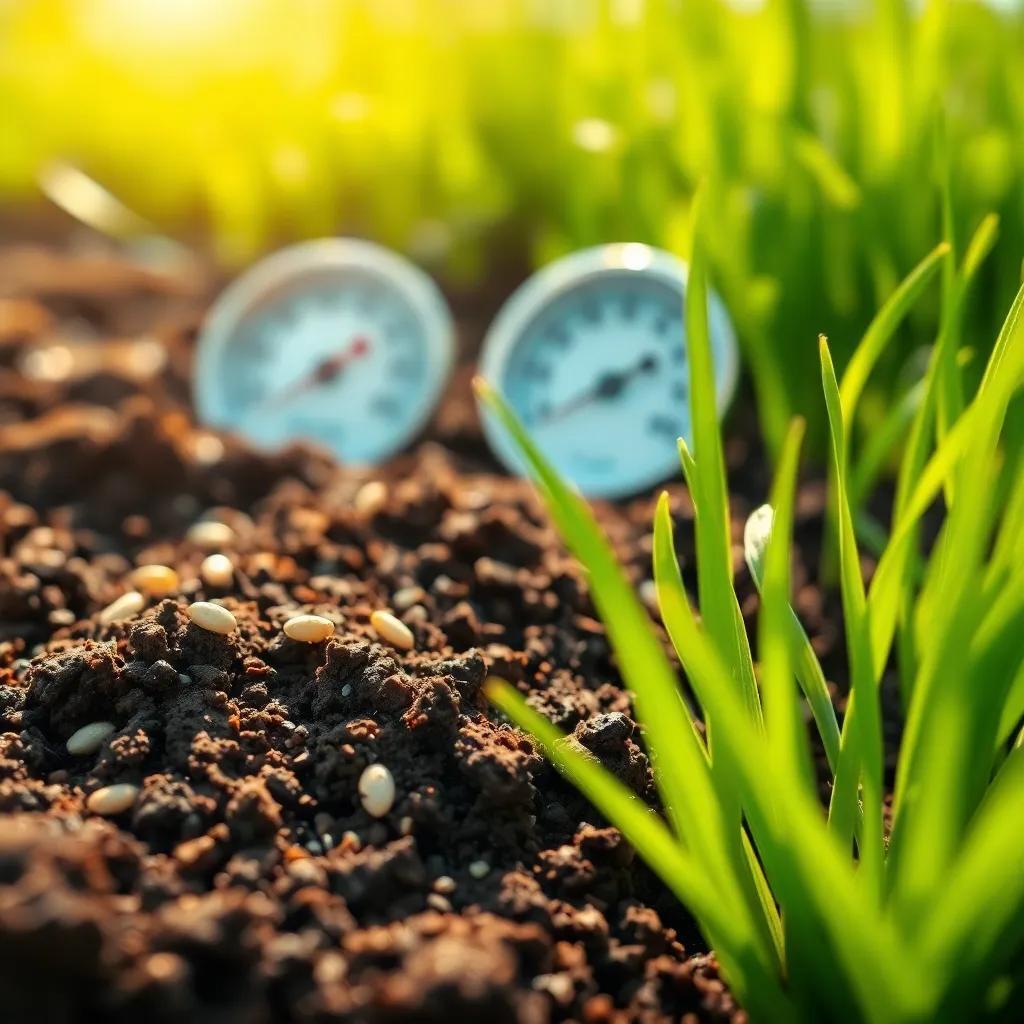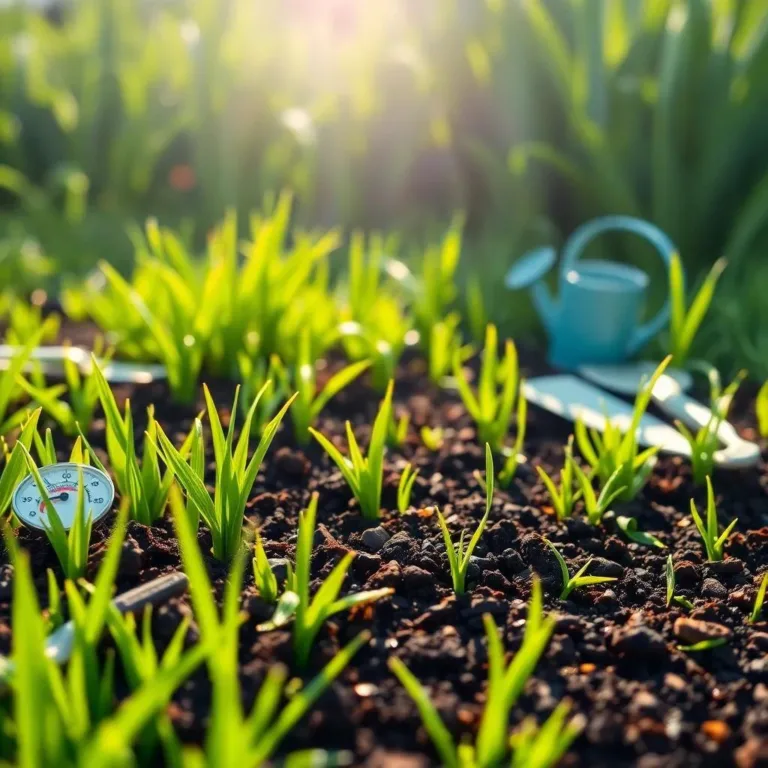Are you ready to transform your lawn into a lush paradise? If you’ve ever wondered how cold is too cold for planting grass seed, you’re in the right place! I’ll share my tips and tricks to help you plant your grass at just the right time, avoiding those chilly pitfalls that can lead to a sad, patchy lawn! Let’s dig in!
Factors Affecting Grass Seed Germination Temperature
When it comes to planting grass seed, temperature plays a big role, and I can’t stress that enough! The right temperature can turn your lawn dreams into reality, while the wrong one can lead to some frustrating results. Let’s break down the key factors you should keep in mind!
- Soil Temperature: This is the superstar of the germination show! Grass seeds need a certain warmth to start sprouting. For warm-season grasses, a cozy soil temperature between 70°F and 90°F is ideal. On the other hand, cool-season grasses are a bit more laid-back, thriving best when the soil is between 45°F and 55°F. If the soil is any colder, it might slow down or even stop germination completely!
- Air Temperature: Did you know air temperature affects soil temperature? Yup! If the air is chilly, the soil is likely to be chilly too. I always look for consistent air temperatures that hover around the sweet spots for my chosen grass type before planting. If it’s too cold outside, I wait! Better safe than sorry, right?
- Frost: Frost is like that annoying friend who always shows up uninvited! It can do serious harm to young grass seeds and seedlings. It’s best to avoid planting when frost is expected. Make sure to check the weather forecast before taking the plunge!
- Moisture: Watering plays a huge part too! If you plant when the soil is too wet or too dry, it could stunt growth or lead to seed rot. Find a nice balance!
- Type of Grass: Not all grasses are created equal! Some love the heat, while others thrive in cooler weather. Knowing your grass type will help you pick the best time for planting.
Understanding these factors will set you up for success, and soon enough, you’ll have a beautiful lawn to enjoy!
Understanding Soil and Air Temperature Requirements
Now that we’ve chatted about germination factors, let’s dive a bit deeper into the temperature requirements! It’s like knowing the perfect baking temperature for that delicious cake. Trust me; you don’t want to mess this up!
Soil Temperature: Here’s the deal—the right soil temperature is the magic key for seed germination. When the soil is warm enough, seeds wake up from their slumber and start to grow! For warm-season grasses like Bermuda or Zoysia, aim for that delightful 50°F to 65°F range. For cool-season types, like Kentucky bluegrass or fescue, 45°F to 55°F is the cozy spot to be in.
How do you check the soil temperature? A simple soil thermometer does the trick! I like to poke it into the ground before planting, just to be sure.
Air Temperature: This is the jacket you wear when you head outside! If it’s too chilly in the air, it probably is down in the soil too. Most grass types thrive when the air temperature is above 50°F. If it’s consistently colder, it might be best to wait.
Here’s a quick checklist to help you remember:
- Warm-season grasses:
– Soil: 70°F – 90°F
– Air: Above 50°F
- Cool-season grasses:
– Soil: 45°F – 55°F
– Air: Above 50°F
By keeping an eye on these temperatures, you can plant your grass seed at just the right time, giving it the best chance to thrive. And who doesn’t want a lush, green lawn to enjoy? Happy planting!

Signs of Damage from Cold-Temperature Planting
Ah, the excitement of planting grass seed! But wait—temperatures drop, and your dreams of a lush lawn might be in jeopardy. It’s super important to recognize the signs of damage from cold temperatures so you can save your precious seedlings. Let’s explore what to look out for!
- Poor Germination: The first sign you might notice is a lack of green! If the seeds struggle to sprout, they’re probably feeling the chill. You might see just a few blades of grass poking through the soil, leaving behind sparse patches. Who wants a patchy lawn? Not me!
- Yellowing or Browning: As seedlings struggle in cold weather, you might see them turn yellow or brown. This discoloration indicates stress, and it’s not a good sign. Healthy grass should be bright green, so if your seedlings look sad, it’s a cry for help!
- Stunted Growth: If your grass seedlings seem to halt in their tracks, that’s another red flag! Cold temperatures can slow their metabolism, leaving them underdeveloped and short. It’s like they’re stuck in slow motion. We want strong, tall grass!
- Increased Weed Competition: When grasses are stunted, weeds can take advantage of the situation. Those pesky intruders love to invade, competing for nutrients and sunlight. They’ll move in quickly if your grass isn’t growing strong.
- Thinning and Patches: Finally, if you notice thinning areas or bare patches, the cold might be to blame. Frost can damage seeds and seedlings, leaving your lawn looking less than perfect.
If you spot any of these signs, don’t worry just yet! With some care and attention, you can help your lawn bounce back to life!
Best Practices for Planting Grass Seed in Cold Weather
Planting grass seed during colder times requires a bit more thought and care. Here are some best practices to follow so your grass can thrive, even when the temperature drops!
- Choose the Right Grass Seed: First, pick a grass variety that thrives in cold weather! Cool-season grasses, like Kentucky bluegrass and perennial ryegrass, are great options. They can handle lower temperatures better than warm-season varieties.
- Monitor Soil Temperature: Before planting, use a soil thermometer to check the soil’s warmth. A good rule of thumb is to plant when the soil is consistently above 50°F. If it’s too cold, your seeds might just sit there and dream of warmer days!
- Avoid Frosty Periods: Keep an eye on the weather forecast! If frost is expected, hold off on planting. Frost can seriously harm your seeds, so it’s best to wait until the temperatures stabilize.
- Prepare the Soil Properly: Make sure your soil is well-drained and clear of debris. Loosen the soil to give your seeds a fighting chance. Adding some organic matter, like compost, can help too!
- Sow Seed at the Right Depth: When planting, follow the guidelines for seed depth. In colder conditions, try to sow the seeds a little shallower than usual to help them germinate faster.
- Water Regularly: Keep the soil moist, but not soggy! Watering is essential, especially during dry spells. Early morning is the best time to water, giving seeds a chance to absorb moisture before the sun gets too hot.
By following these tips, you’ll be on your way to a beautiful lawn, even in chilly conditions!
Optimal Grass Seed Varieties for Cold Climates
Choosing the right grass seed variety is like picking the perfect friend for a cold winter night—some are just better suited for the chill! Here’s a breakdown of the optimal grass seed varieties that will flourish in cold climates.
- Kentucky Bluegrass: This classic grass is a perfect choice for cool-season areas. It’s known for its rich color and thick texture. Plus, it has excellent self-repairing capabilities—who wouldn’t want a dependable friend like that?
- Perennial Ryegrass: Want quick results? Perennial Ryegrass germinates faster than other varieties! It’s ideal for quick patches and is also tolerant of cooler temperatures.
- Tall Fescue: Looking for drought resistance? Tall Fescue has deep roots and can handle dry spells, making it a versatile choice for various climates. Plus, its coarse texture adds character to your lawn!
- Fine Fescue: If you’re aiming for a low-maintenance option, fine fescue is excellent! It’s tolerant of shade and doesn’t require too much water. Ideal for those tricky, shady areas in your yard!
- Creeping Red Fescue: This is a champion in shade! It spreads easily and thrives in cool, damp conditions. It’s perfect for those tricky spots where sunlight doesn’t shine.
These grass seed varieties are all stars when it comes to colder climates. Choose wisely, and soon you’ll have a lush lawn to show off! Happy planting!

